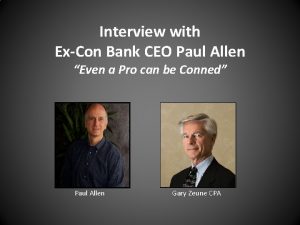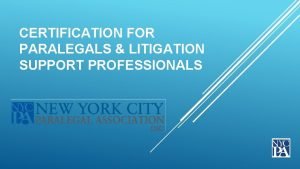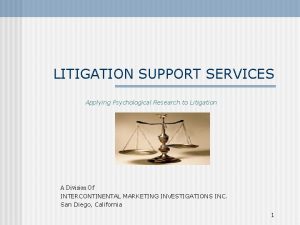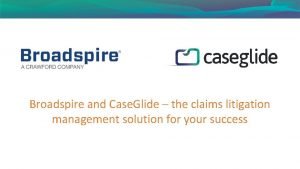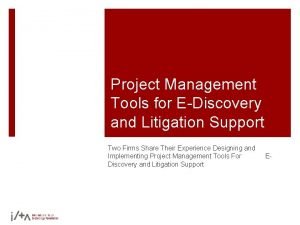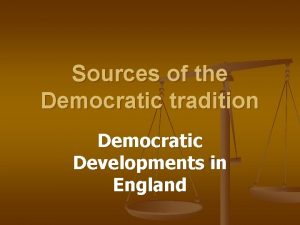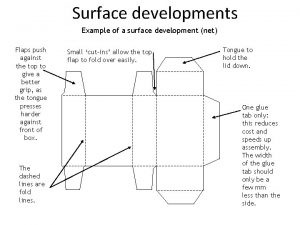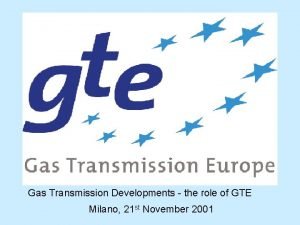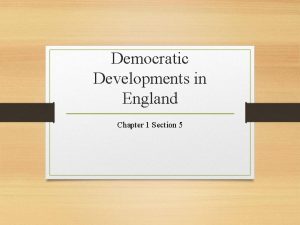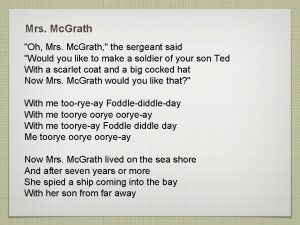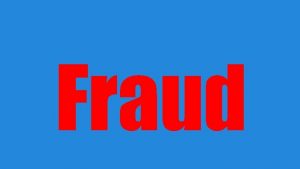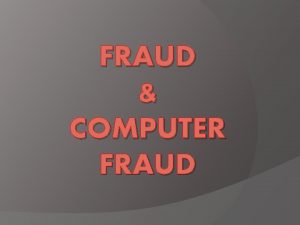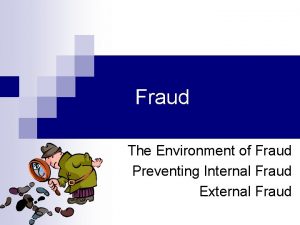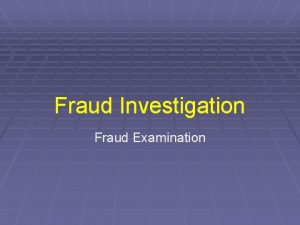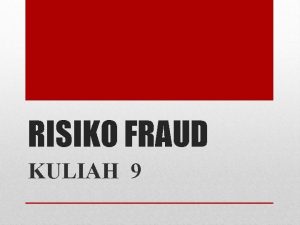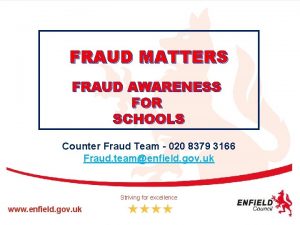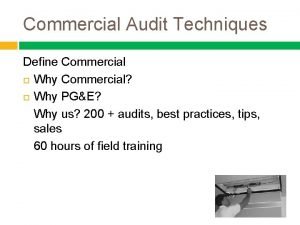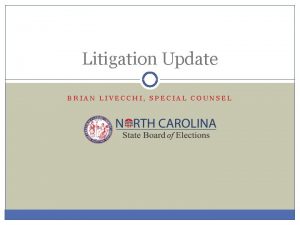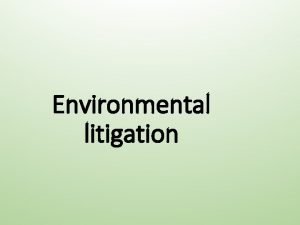Commercial Fraud Litigation 6 Developments Paul Mc Grath







![Freezing Orders and Loans (1) JSC BTA Bank v Ablyazov [2015] UKSC 64 D Freezing Orders and Loans (1) JSC BTA Bank v Ablyazov [2015] UKSC 64 D](https://slidetodoc.com/presentation_image_h/7a27844c5c786a48b6e25d7646699979/image-8.jpg)














- Slides: 22

Commercial Fraud Litigation: 6 Developments Paul Mc. Grath Q. C. pmcgrath@essexcourt. net Essex Court Chambers 2016

Overview Freezing Orders and Discretionary Trusts Freezing Orders and Assets by a Company Freezing Orders and Loans Piercing the Corporate Veil after Prest v Petrodel Enforcement: Hague Convention on Choice of Court Agreements Enforcement: DIFC Practice Direction No 2 of 2015

Freezing Orders & Discretionary Trusts – most important asset holding structure Purpose of FO: to protect assets susceptible to enforcement: BTA Bank v Solodchenko [2011] 1 WLR 888 (Patten LJ) Assets of DTs not available for execution: beneficiary does not have a proprietary interest in DT’s assets. No surprise assets of DT fall outwith standard form FO: Federal Bank of Middle East v Hadkinson [2000] 1 WLR 1695 (CA) Such assets also fall outside the revised Commercial Court standard wording which includes assets whether “owned legally, beneficially or otherwise”: Chadwick LJ in Raja v Van Hoogstraten [2004] 4 All ER 793 rejected by CA in Solodchenko [2011] 1 WLR 888 Issue recently raised in the £ 1. 2 billion WFO obtained against Sergei Pugachev

Discretionary Trusts & Pugachev SP had disclosed he was a beneficiary under DTs but no further details. CA re-asserted basic principle: assets of DT outside ambit of WFO: [2015] EWCA Civ 139 Standard Order varied to include in disclosure section: “any interest under a trust or similar entity including any interest which may arise by virtue of the exercise of any power of appointment, discretion or otherwise howsoever. ” CA held: new wording required SP to disclose his “interest” as beneficiary which he had done. AND, because there was “some credible material” that the DTs were not valid, (see CPR Part 25. 1. 1(1)(g) per G Moss QC in Parker v CS Structured Credit), the Court could order more detailed disclosure of assets held under the DTs in order to verify validity of the DTs and police order. CA: expressly drew distinction between threshold for disclosure (Some credible material) and threshold for inclusion of assets under the WFO prohibition (good reason to suppose: Henderson J in Lichter v Rubin [2008] EWHC 450).

Discretionary Trusts & Pugachev (2) SP then fled the jurisdiction: Cls obtained an order extending WFO to include assets held on DT on the following grounds: That trusts were a sham and therefore within Chabra jurisdiction That good arguable case to those assets under s. 423 of the Insolvency Act 1986 or s. 339 of Act (transaction at an undervalue. That SP exercised sufficient degree of control over those assets that it was appropriate to infer from this fact that there existed a mechanism available to satisfy any future judgment against these assets e. g TSMF v Merrill Lynch Bank [2011] UKPC 17 (very useful PC decision) This extension did not result from the additional wording but from the conduct of SP

Assets by a corporate entity If a company is owned by the D. To what extent, if at all, does a WFO against the D affect the assets held by the Company? English Company Law: a shareholder does not own the assets of the company: Salomon v Salomon CA in Lakatamia Shipping [2015] 1 WLR 291 re-asserts that basic proposition in WFO context. Argued that the extended definition of “assets” in WFO standard form may lead to different conclusion i. e. “For the purpose of this order the Respondent’s assets include any asset which he has the power, directly or indirectly, to dispose of or deal with as if it were his own. The Respondent is to be regarded as having such power if a third party holds or controls the asset in accordance with his direct or indirect instructions. ”

Assets by Corporate Entity (2) Lakatamia: control alone not enough: So even if D is sole owner of the company, and able to exert control over its assets, those assets not within terms of WFO: Group Seven v Allied Investment Corp [2014] 1 WLR 735. But value of D’s assets (shares) dependent in turn on value of assets of company. Lakatamia: Assets of company outside WFO but D is prohibited from procuring the company to dissipate its assets. If want company assets to fall directly within WFO need lift the corporate veil: Prest v Petrodel and earlier authorities.
![Freezing Orders and Loans 1 JSC BTA Bank v Ablyazov 2015 UKSC 64 D Freezing Orders and Loans (1) JSC BTA Bank v Ablyazov [2015] UKSC 64 D](https://slidetodoc.com/presentation_image_h/7a27844c5c786a48b6e25d7646699979/image-8.jpg)
Freezing Orders and Loans (1) JSC BTA Bank v Ablyazov [2015] UKSC 64 D raised several $10 m loans and used to pay expenses including some $16 m to Stephenson Harwood for his defence fees. Bank argued: either the right to drawdown on the loans or the loan proceeds themselves amounted to assets under the terms of the WFO Supreme Court held: (1) Not an “asset” within non-extended WFO Chose in action could be an asset: many examples in other contexts but question was whether it was appropriate for it to be characterised as an asset in this context. Enforcement principle suggests not Settled view: loans outwith the WFO: certainty important in such orders (2) Accordingly, distribution was not a disposal of an asset so long as concerned with pre -2002 definition of asset

Freezing Orders and Loans (2) On alternative argument, SC held loan proceeds did fall within extended definition of assets ie “For the purpose of this order the Respondent’s assets include any asset which he has the power, directly or indirectly, to dispose of or deal with as if it were his own. The Respondent is to be regarded as having such power if a third party holds or controls the asset in accordance with his direct or indirect instructions. ” Extended Definition includes: any asset which D has the power, directly or indirectly, to dispose of or deal with as if it were his own. Intended to include assets not legally or beneficially owned by D yet under D’s control.

Freezing orders and Loans (3) D had that level of control under the terms of the loan agreements and “an instruction to pay the lender’s money…to a third party is dealing with the lender’s assets as if they were his own. ” Importance? Elevates “control” alone as a criteria for qualification as an asset. Cf Lakatamia – inconsistent? What type of control? Legal or actual/de facto? Open door to circumvent need to satisfy criteria for sham trusts if can show level of actual control? Some offshore DTs will afford settlor considerable control over the assets. Will that suffice for the purposes of bringing those assets within a WFO? Perhaps under the TSM v Merrill Lynch jurisidiction?

Piercing the Corporate Veil after Prest v Petrodel Not ratio Theory of a limited doctrine not command majority in Prest Important contribution and influential to future direction Older authorities still hold true P Mc. Grath Q, . C. Essex Court Chambers 2016

Need for an effective doctrine of lifting the veil Increasingly complex structures used to: perpetrate fraud whilst disguising individuals involvement launder the proceeds of the fraud hold the assets English law must be capable of meeting and adapting to these demands Lord Sumption: recognised this need: but his answer was not to emphasise a strong flexible doctrine it was to suggest greater use of less controversial arguments e. g. agency/nominee coupled with limited residual category No reason why cant have both

EVASION V CONCEALMENT Core Distinction CONCEALMENT: involves the interposition of a company so as to conceal the identity of the real actors. Court not disregarding the veil, simply looking behind it to discover the facts which the corporate structure is concealing. EVASION: Court may disregard the veil if there is: a legal right against the person in control of it which exists independently of the company’s involvement, and a company is interposed so that the separate legal personality of company will defeat the right or frustrate its enforcement.

Evasion v Concealment: Two Sides of the Same Coin? Concealment: Defining feature of doctrine Central to concept of (ab)use of corp structure Both Concealment and Evasion involve: Search for true actors – those truly responsible corp. structure dishonestly (ab)used to disguise involvement of true actor in order to evade liability for the relevant wrongdoing No (obvious) material distinction

EVASION V CONCEALMENT Existing v Future Liability? Evasion: liability which is existing and arises independently of involvement of company Concealment: sub-silentio: future liability created by the involvement of the company Is doctrine really dependent upon: Issues of timing of impropriety A distinction between (ab)use of a cpy in carrying out a wrong and in disguising a wrong already committed? Such fine distinctions sit uncomfortably with wide juridical basis/public policy As a matter of application, distinction not evident between Gilford v Horne and Trustor/Gencor

Gilford v Horne: Lord Sumption’s evasion example Lord Sumption says: Mr H’s liability existed independent of involvement of the company; AND Mr H had interposed the company so as to evade his own liability for the garage business Accept had an existing obligation but his liability required breach of that obligation which was dependent (i) on the conduct of the company (operating garage) (ii) Mr being responsible for that conduct Difficult to see how Mr H’s liability truly independent of the company on these facts

Trustor/Gencor: examples of evasion? But what is the material and clear distinction between: Cpy operating the garage business in G v H; and Cpy receiving the misappropriated funds in Trustor ? In both, the wrongdoing conduct (garage operation/receipt of funds) was being perpetrated by a corporate entity In both, cpy used so as to disguise the involvement of the individuals In both, answer would be the same if the cpy operated as agent for Mr H or the Ds Concerned that Lord Sumption’s theory jettisons such established cases on lifting the veil and in an unconvincing manner Even Lord Neuberger (Lord Sumption’s strongest supporter in Prest) considers Gilford to be a case of concealment not evasion. What hope for the distinction?

Jones v Lipman VTB v Nutritek: no piercing of the veil to impose a contractual jurisdiction clause on a non-party. Jones v Lipman: injunction to enforce the contractual obligation to transfer imposed on the company (not party to contract). Lord Sumption in Prest: “The judge must have thought that in the circumstances the company should be treated as having the same obligation to convey the property to the plaintiff as Mr Lipman had even though it was not party to the contract of sale. ” [30] Consistent with prohibition in VTB?

Concluding Observations Principle of Salomon v Salomon nothing to fear from a strong flexible doctrine Only operates against an individual against whom a good arguable case of impropriety has been established Only uncertainty that arises with a strong flexible doctrine is on the part of the fraudster’s entitlement to rely upon and benefit from the separate legal personality of the company Acceptable uncertainty

Enforcement: Hague Convention on choice of court Art 3: Concerns jurisdiction taken under an exclusive jurisdiction clause Art 5: chosen court must hear the case (limited exceptions) – no forum conveniens Art 6: a court other than that chosen in excl jurisdiction clause must stay matter: no parallel proceedings/inconsistent judgments Art 8: recognition and enforcement of judgments based on excl jurisdiction clauses without review of the merits (limited scope to challenge). On 1 st October 2015, Hague Convention effective as between EU states and Mexico. US and Singapore also signed up but not yet ratified. One to watch in future P Mc. Grath Q, . C. Essex Court Chambers 2016

Enforcement: DIFC Practice Direction No. 2 of 2015 Dubai: increasing importance as location of assets and Ds to international commercial litigation: cant be ignored. DIFC (an offshore jurisdiction within Dubai practising common law) considering its position as to Hague Convention: PD No 2 of 2015: effectively converting a dispute about payment of a DIFC judgment into an arbitral matter leading to an award from DIFC-LCIA Enforceable under the New York Convention. Novel and innovative; recognises importance of enforceable judgments. SICC seriously considered it but decided to go down the Hague Convention route first Controversial but another one to watch. P Mc. Grath Q, . C. Essex Court Chambers 2016

Conclusions Unless varied, the standard form WFO does NOT require disclosure of interest as beneficiary under a WFO. Disclosure under a WFO may extend to whether someone is a beneficiary under a DT but unless some credible material exists that those DTs are not valid, no further disclosure required. Assets under a DT remain outside the prohibition effect of a WFO unless and until there is good reason to suppose the DTs are not valid ie sham etc. WFO wording alone does not get you there. Assets of a company owned by a D are not within the WFO but the D is prevented from procuring the dissipation of those assets. Anything more direct requires lifting the veil. Loan proceeds do fall within extended WFO if sufficient control is exercised over those proceeds. Unclear how far “control” will be taken as an independent qualifying criteria. Be aware of developments relating to Hague Convention and DIFC PD No 2 on issues of enforcement. P Mc. Grath Q, . C. Essex Court Chambers 2016
 How do fraud symptoms help in detecting fraud
How do fraud symptoms help in detecting fraud Nicole grath
Nicole grath Grath math
Grath math Paul r allen mortgage
Paul r allen mortgage Commercial food service operation
Commercial food service operation Association of litigation support professionals
Association of litigation support professionals Research & litigation support
Research & litigation support Case glide
Case glide Project management tools for ediscovery and litigation
Project management tools for ediscovery and litigation Huron creek developments reviews
Huron creek developments reviews Mdi medical devices international
Mdi medical devices international Target developments
Target developments Cultural development of sahelanthropus tchadensis brainly
Cultural development of sahelanthropus tchadensis brainly Democratic developments in england
Democratic developments in england Surface developments
Surface developments Donmeg developments
Donmeg developments Definition as pattern of development
Definition as pattern of development Chartered developments
Chartered developments Cplim
Cplim Transmission developments
Transmission developments Recent developments in ict
Recent developments in ict Democratic developments in england
Democratic developments in england Pattern in development
Pattern in development



